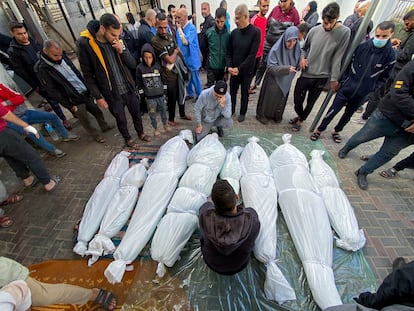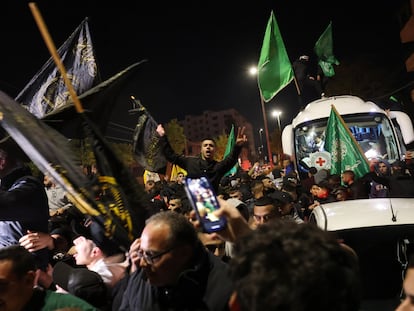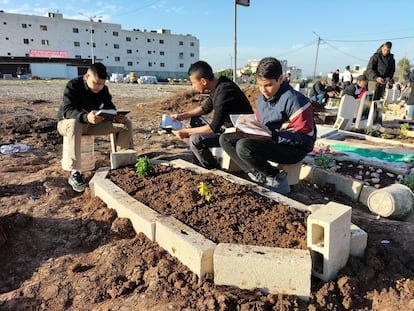Fear and death return to Gaza: ‘They are bombing even more than before’
UNICEF spokesman James Elder and two residents of the Strip recount the situation after the end of the truce. ‘We are waiting for the world to do something to protect us, but we have no more hope’


Not even 30 seconds had passed since the end of the truce between Israel and Hamas at 7 a.m. Friday when a missile began “to trace its path” in the sky over Gaza, UNICEF spokesman James Elder said by telephone from an unspecified location in the south of the Palestinian territory. The Australian rushed “immediately” to Nasser Hospital, the largest in the south of the Strip. There, the faces of “traumatized” people, living in “horrendous conditions” and “savagely overcrowded” once again showed “the return of death and fear, the worst nightmare of all,” said the UNICEF official. For Elder, what is happening again in Gaza after the brief respite of a week’s ceasefire, is “a war against children.”
Elder points to the figures provided by the Ministry of Health in the enclave, which estimates that more than 6,000 children have been killed by Israeli attacks in Gaza, representing almost half of the more than 15,000 people who have perished in the Strip since the beginning of the war seven weeks ago. Those figures were endorsed Thursday by the United Nations, which considers them credible. “Everybody knows those numbers now. We have reports of 6,000 children killed. UNICEF is an apolitical and impartial organization, but let’s look at those numbers: those 6,000 [dead] children show that this war is devastating,” Elder said.
Doaa Ulyan, a 33-year-old Gazan refugee living in Rafah with her husband and two children, aged 10 and 8, also finds the situation in Gaza “terrifying.” Via WhatsApp she explained how, since 7 a.m. Friday, Israel had been shelling “even more than before.” Originally from Gaza City, Ulyan fled, like hundreds of thousands of her fellow citizens, to the south when Israel ordered the population to evacuate there on October 12. Some 1.7 million of the Strip’s 2.3 million inhabitants are now crowded into the southern part of the enclave.
Shortly after the truce expired the Israeli army leafleted southern Gaza, ordering a new evacuation, this time in the direction of Rafah, on the border with Egypt. But that area was also heavily bombed as soon as the Israeli offensive resumed.

“They told us to go south and we did, and then they started shelling like crazy,” Ulyan said. “The massacres shown in the images from Gaza are proof enough of the atrocities being committed against innocent civilians. We are waiting for the world to do something to protect us, but we have no more hope and can only ask God to protect us,” Ulyan said.
The Gaza Health Ministry reported at least 178 people were killed in Friday’s bombardment. The 600 or so wounded that the Strip’s health authorities have recorded will only have recourse to a health system that the war has brought “to its knees,” according to Elder.
If the international community “does not act,” Elder said, it will represent “a green light for more children to be killed.” The U.N. official finds it “disheartening that there are so many people who seem to be comfortable” with what is happening in Gaza. At the Nasser Hospital, “the children were absolutely terrified. Every single child in Gaza is going to need mental support and they can’t get it until this war is over. There are still 1.1 million children in the Strip.”
The lives of many of these children have been changed “forever,” said Elder. In the Palestinian territory, according to data from the Strip’s health authorities, there are “some 2,000 children who have had amputations, such as little Sharma, one year old, who has lost her right leg and arm.”
“Those who have the power to do so must stop this. The longer [this war] goes on, the deeper the scars will be. We can’t begin to look for healing until these atrocities end,” Elder said. Children who two months ago may have been “in their room at their computers” are now forced to look in fear at a sky from which “bombs are raining down.”
My mom is telling me we are left with one option, to accept death. It doesn't matter if we move or not, any minute now is our last. They say leave Khan Younis for Rafah then strike Rafah. We have no where to go. If we die at least we die in the house not out on the streets...
— Jehan Alfarra (@j_alfarra) December 1, 2023
“We have nowhere to run”
From Khan Younis, 53-year-old Jalil Abu Shamaleh, a former director of the human rights NGO Addameer, on Friday provided this newspaper with several WhatsApp audios in which the incessant roar of warplanes and the buzzing of drones could be heard. Shamaleh also stated that the bombs had not stopped falling since 7 a.m.
“People are terrified. They have seen too many people killed before the truce. Most Gazans don’t dare go out on the streets. You don’t know who might be the next target. Those who venture out do so because they have to meet some urgent need. [The Israelis] have told us to leave, but we have nowhere to run,” he said.
The town of Khan Younis, where Shamaleh is sheltering, is one of those that Israel has ordered to evacuate, but some Gazans who sought safety there no longer want to leave. “My mom is telling me we are left with one option, to accept death. It doesn’t matter if we move or not, any minute now is our last. They say leave Khan Younis for Rafah then strike Rafah. We have no where to go. If we die at least we die in the house not out on the streets...” Gazan journalist Jehan Alfarra posted on social media Friday.
Sign up for our weekly newsletter to get more English-language news coverage from EL PAÍS USA Edition
Tu suscripción se está usando en otro dispositivo
¿Quieres añadir otro usuario a tu suscripción?
Si continúas leyendo en este dispositivo, no se podrá leer en el otro.
FlechaTu suscripción se está usando en otro dispositivo y solo puedes acceder a EL PAÍS desde un dispositivo a la vez.
Si quieres compartir tu cuenta, cambia tu suscripción a la modalidad Premium, así podrás añadir otro usuario. Cada uno accederá con su propia cuenta de email, lo que os permitirá personalizar vuestra experiencia en EL PAÍS.
¿Tienes una suscripción de empresa? Accede aquí para contratar más cuentas.
En el caso de no saber quién está usando tu cuenta, te recomendamos cambiar tu contraseña aquí.
Si decides continuar compartiendo tu cuenta, este mensaje se mostrará en tu dispositivo y en el de la otra persona que está usando tu cuenta de forma indefinida, afectando a tu experiencia de lectura. Puedes consultar aquí los términos y condiciones de la suscripción digital.
More information
Archived In
Últimas noticias
All the effects of gentrification in one corner of Mexico’s Colonia Roma
Palestinian reporter Youmna El Sayed: ‘My family told me I had to choose between being a journalist or a mother’
‘Sleepless City’: The light of cinema illuminates Madrid’s Cañada Real shantytown
The new language of the workplace: Knowing how to ask AI questions is more important than using it
Most viewed
- Families demand repatriation of bodies of Colombians who died in Ukraine: ‘This war is a slaughterhouse for foreigners’
- The low-cost creative revolution: How technology is making art accessible to everyone
- Liset Menéndez de la Prida, neuroscientist: ‘It’s not normal to constantly seek pleasure; it’s important to be bored, to be calm’
- Christian Louboutin: ‘Young people don’t want to be like their parents. And if their parents wear sneakers, they’re going to look for something else’
- ‘El Limones’ and the growing union disguise of Mexican organized crime










































